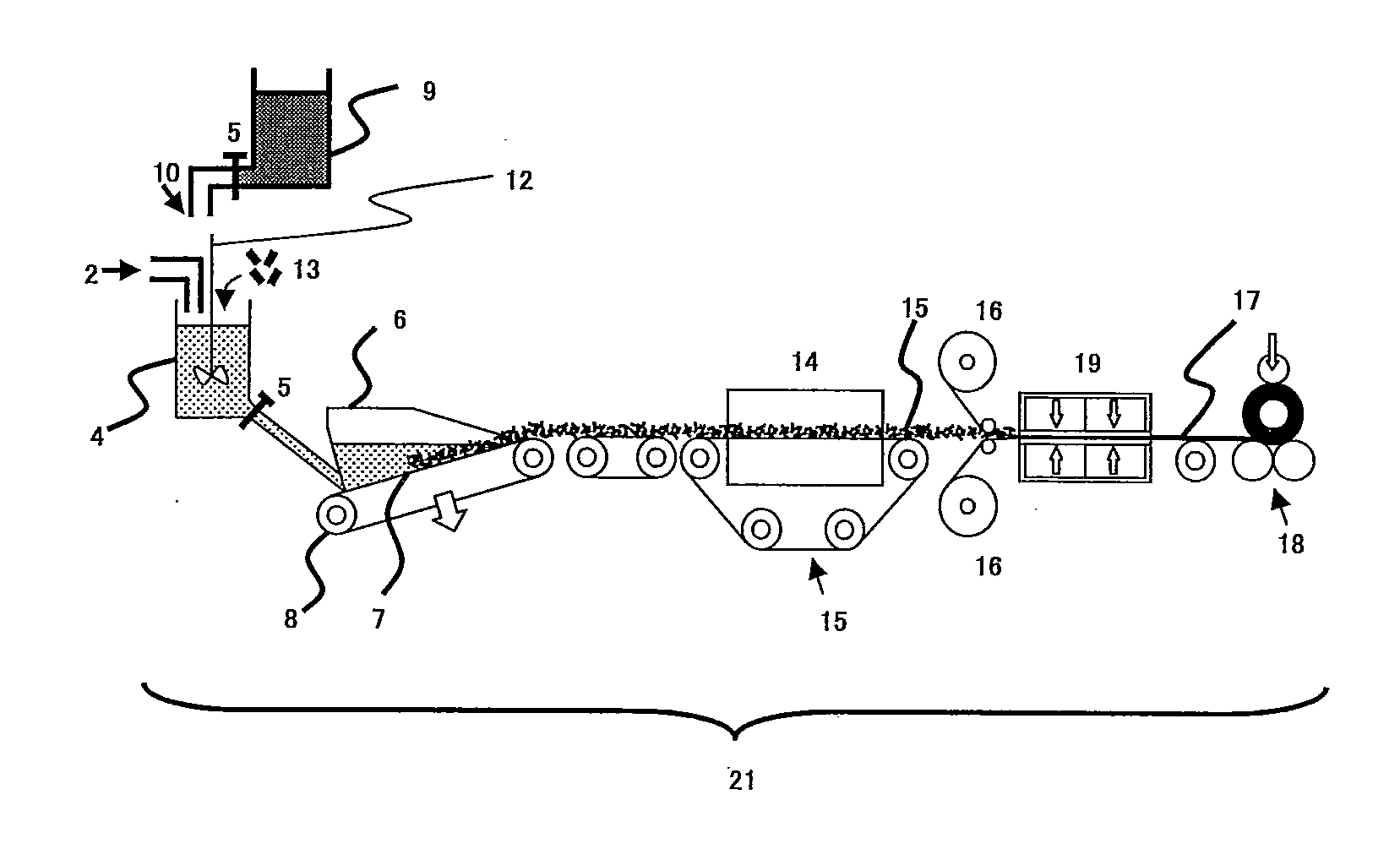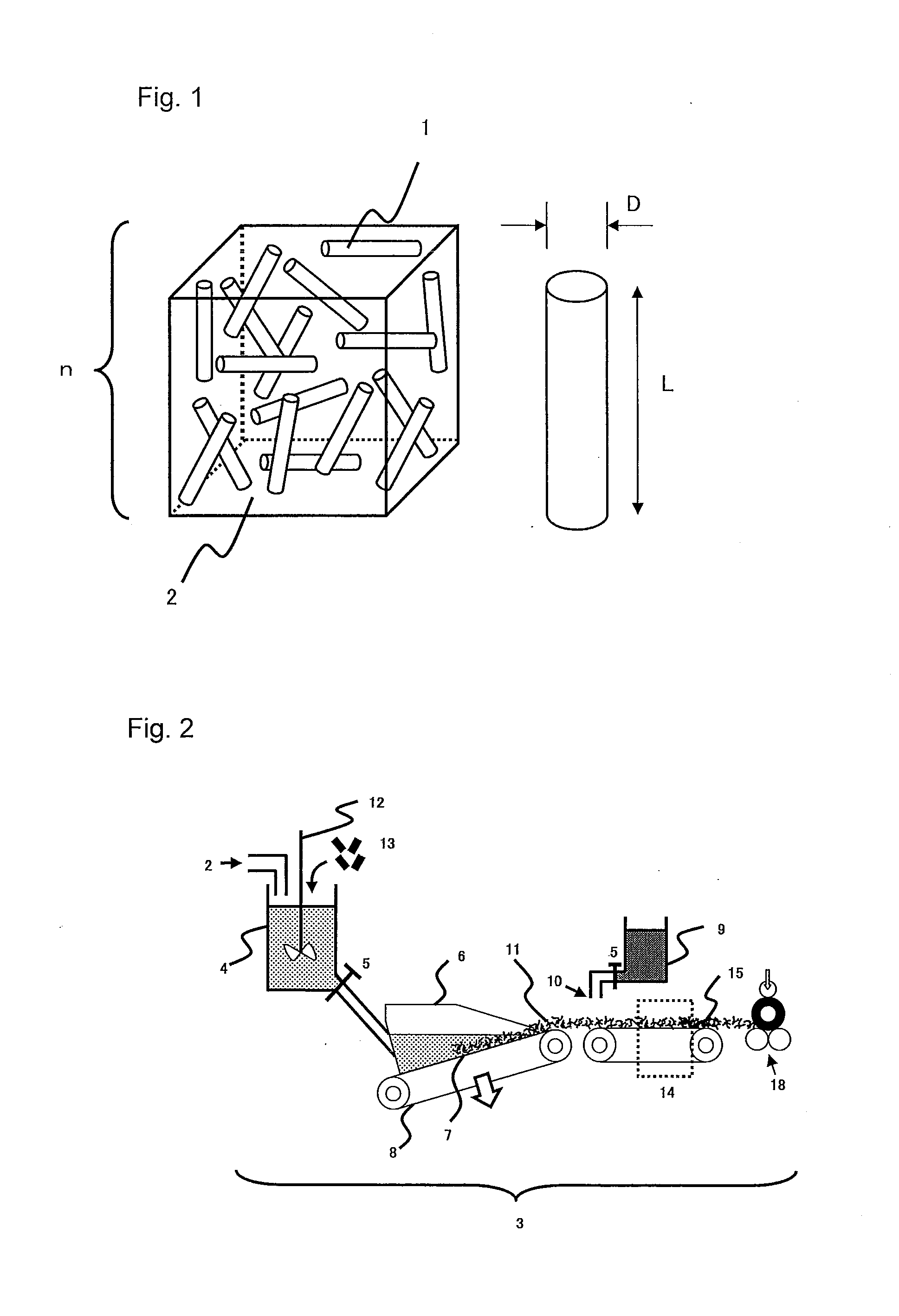Fiber-reinforced thermoplastic resin composition, reinforcing fiber bundle, and process for production of fiber-reinforced thermoplastic resin composition
a thermoplastic resin and fiber-based technology, applied in the field of fiber-based thermoplastic resin composition, can solve the problems of low polarity of polyolefin-based resin, inferior interface adhesiveness of reinforcing fibers, insufficient interface adhesiveness, etc., and achieve excellent mechanical properties, good interface adhesiveness, and excellent adhesiveness
- Summary
- Abstract
- Description
- Claims
- Application Information
AI Technical Summary
Benefits of technology
Problems solved by technology
Method used
Image
Examples
reference example 1
Method for Manufacturing Injection-Molded Product
[0247]A reinforcing fiber bundle on which a (meth)acrylic-based polymer was adhered was obtained by providing the reinforcing fiber bundle with an emulsion or an aqueous solution of a (meth)acrylic-based polymer by dipping and then drying at 140° C. for 5 minutes. The adhered amount was adjusted using either appropriately adjusting the concentration of the emulsion or aqueous solution of a (meth)acrylic-based polymer or repeating dipping and drying several times, or performing both of them. The resulting reinforcing fiber bundle was cut to a length of ¼ inch by a cartridge cutter to obtain chopped threads.
[0248]Using a TEX-30α type twin screw extruder (30 mm in screw diameter and L / D=32) (manufactured by Japan Steel Works Co., Ltd.), thermoplastic resin was supplied from the main hopper. Subsequently, the chopped treads were supplied from the side hopper located on the downstream side and then kneaded at a screw rotation speed of 150 ...
reference example 2
Method for Manufacturing Press-Molded Product
[0250]A reinforcing fiber bundle was cut to a length of ¼ inch by a cartridge cutter to obtain chopped threads.
[0251]To a dispersion solution consisting of water and a surfactant (polyoxyethylene lauryl ether (trade name), manufactured by Nacalai Tesque, Inc.) at a concentration of 0.1 mass %, the chopped threads were added so that the chopped threads would have a fiber content by mass of 0.02 mass %. After preparing a slurry by stirring for 5 minutes, water was removed by aspiration, thereby obtaining a reinforcing fiber substrate of 300 mm in square. Next, from the upper side of the reinforcing fiber substrate, an emulsion liquid containing 1 mass % (meth)acrylic-based polymer was sprayed. The excess emulsion liquid was removed by aspiration and then drying was performed at 200° C. for 15 minutes, thereby obtaining a reinforcing fiber substrate provided with the (meth)acrylic-based polymer. The adhered amount is described in the table.
[...
example 1-1
[0270]An injection-molded product was obtained in a manner described in Reference example 1 using reinforcing fiber A1, (meth)acrylic-based polymer P(1), and thermoplastic resin (acid modified polypropylene resin). The evaluation results are summarized in Table 1-2.
PUM
| Property | Measurement | Unit |
|---|---|---|
| Percent by mass | aaaaa | aaaaa |
| Percent by mass | aaaaa | aaaaa |
| Percent by mass | aaaaa | aaaaa |
Abstract
Description
Claims
Application Information
 Login to View More
Login to View More - R&D
- Intellectual Property
- Life Sciences
- Materials
- Tech Scout
- Unparalleled Data Quality
- Higher Quality Content
- 60% Fewer Hallucinations
Browse by: Latest US Patents, China's latest patents, Technical Efficacy Thesaurus, Application Domain, Technology Topic, Popular Technical Reports.
© 2025 PatSnap. All rights reserved.Legal|Privacy policy|Modern Slavery Act Transparency Statement|Sitemap|About US| Contact US: help@patsnap.com



